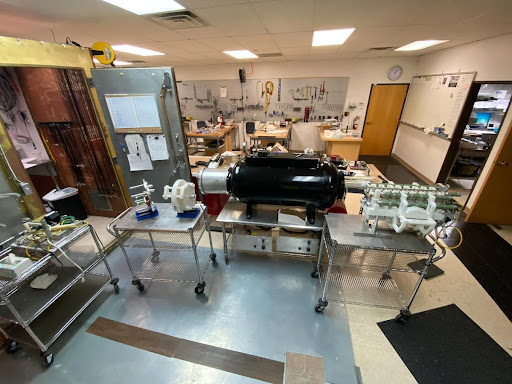
NERS awarded funding from the Department of Defense for new pulsed power driver
The equipment will be located in the Plasma, Pulsed Power, and Microwave Laboratory.

The equipment will be located in the Plasma, Pulsed Power, and Microwave Laboratory.
The U-M Department of Nuclear Engineering & Radiological Sciences (NERS) has received funding from the U.S. Department of Defense (DoD) for a compact pulsed power driver. The driver will be used to supply repeatable voltage and current pulses to High Power Microwave (HPM) oscillators and amplifiers under development in the Plasma, Pulsed Power, and Microwave Laboratory (PPML). Installation is expected to be completed by the end of 2022.
The award is part of DoD’s Deference University Research Instrumentation Program. The program, administered through a merit competition jointly by the Air Force Office of Scientific Research, Army Research Office, and Office of Naval Research, is highly competitive.
The proposal was titled “Repetitive Marx Generator for High Power Microwave Research”, and submitted by NERS associate research scientist Nicholas Jordan. This research is highly relevant to the DoD requirements for compact HPM generators and their associated pulsed power drivers, as the proposed system is already in use at Air Force Research Laboratory (AFRL) and in multiple high power microwave demonstration systems within the DoD. The proposed cost of this pulsed power system is $215,000. The equipment will be maintained by Dr. Jordan and used by his research group which includes NERS professors Ronald Gilgenbach and Ryan McBride.
The new equipment includes a Marx capacitor bank capable of producing 20–400 kilovolts, 100–200 nanosecond voltage pulses with a 50 nanosecond rise-time. At peak power, this system can supply 400 kilovolts and 10 kiloampere, or about 4 gigawatts.
This pulsed power system will bring immediate benefit as the driver for the AFOSR-funded Recirculating Planar Magnetron with Coaxial All-Cavity Extraction (RPM-CACE). RPM-CACE is an efficient HPM source designed and simulated by U-M in partnership with AFRL and is currently the centerpiece of our grant “HPM Frequency, Phase, and Mode-Locking of Recirculating Planar Magnetrons”. Additionally, this system will be used as the pulsed power driver for crossed-field amplifiers designed in UM’s portion of the AFOSR-funded MURI, “Exploration of Fundamental Limits to High Power Electromagnetic Amplification.” This research will explore the fundamental physics which limit the power, gain, and bandwidth of HPM amplifiers.
By providing a stable, repeatable, repetitive voltage pulse with a fast rise-time, this pulsed power system will improve the characterization of operating parameters achievable for the future HPM sources researched at U-M, and a high repetition rate will allow us to collect meaningful statistical data on device performance. However, this equipment will probably not be used for any classes, and there are no current plans for use by any other departments or research groups.
The flexibility of this pulsed power driver, coupled with U-M’s expertise and existing HPM/pulsed power hardware, is also a promising combination for future pulsed power research and development. The repetitive and burst-fire pulse limits of the pulser are an area that could be pursued, as an improved understanding of the fundamental and engineering limits to pulse repetition rate will have a substantial impact on fielded DoD HPM systems.